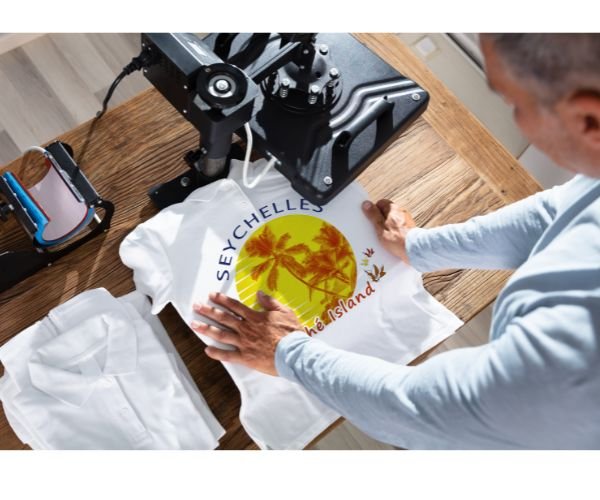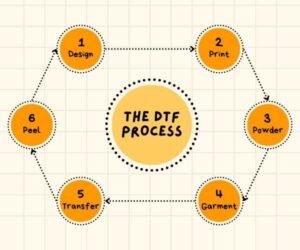Are you the kind of person who always wears a T shirt as it is comfortable and easy to wear? Do you want to start a new business and become an entrepreneur? Starting a T shirt printing business can be an ideal opportunity for anyone who wants to run their own business. T shirt printing has always been a lucrative business, especially in the fashion industry, where customers always look for new and trendy T shirts to wear. However, starting a T shirt printing business requires effort, innovation, and knowledge about the latest trends in the fashion industry. This article will provide an overview of how to start a profitable T shirt printing business, from researching the market to creating a business plan, setting up the T shirt printing business, to promoting the brand and ultimately selling the T shirts.
Researching the T shirt Printing Business
The first step in any business venture is to conduct a thorough research about the business niche. In T shirt printing, it is essential to research the target market, market segments, and competition.
Understanding the Market Segments
The T shirt printing business is widespread and varied in nature. Therefore, it is essential to study its market and understand the various segments that exist in the industry. There are different categories of T shirts based on gender, age, style, material, and design. A thorough understanding of these segments will help you create personalized product offerings for different niches.
In general, the T shirt market can be broadly divided into the following segments:
- Basic T shirts: As the name suggests, this category of T shirts consists of basic, plain T shirts that are usually worn as casual wear. They are made of cotton or cotton blends and come in standard sizes.
- Designer T shirts: This category of T shirts includes T shirts designed by designers or fashion brands. These T shirts are more expensive and are made of high-quality materials such as silk or linen.
- Sports T shirts: Sports T shirts are designed especially for athletes and sports enthusiasts. They are made of breathable and stretchable fabric that helps in sweat absorption.
- Promotional T shirts: Promotional T shirts are used by businesses for advertising and creating brand awareness. They usually come with a company logo or slogan printed on them.
Identifying the Target Customers
Identifying your target customers will help you understand their specific preferences and needs. It will also help you tailor your product offerings to suit their demands. There are several questions that you should ask yourself while identifying your target customers.
- What age group am I targeting?
- What is the gender breakdown that I’m targeting?
- What is their buying habits like? Are they interested in buying high-end, designer T shirts or do they prefer cheaper, plain T shirts?
- What is their income level, and how much are they willing to spend on T shirts?
- What are their interests and hobbies, and how can I use this knowledge to market my T shirts to them?
Learning About the Competition
Understanding your competition is essential to create a sustainable business strategy that helps you stand out from the crowd. Analyzing your competitors’ business models, product offerings, pricing strategies, and marketing tactics can provide you with valuable insights that you can use to create a better and more effective business plan.
To research your competition, start by identifying the key players in the T shirt printing industry in your area. You can do this by conducting online searches and visiting local stores that sell T shirts. Once you have a list of competitors, analyze their products, their target customers, and their unique selling points. This will help you identify gaps in the market and create a business strategy that caters to the unmet needs of your target customers.
Creating a Business Plan
Creating a Business Plan for your T shirt Printing Business is an essential step towards laying the foundation for a successful venture. A Business Plan is a written document that outlines your business goals, objectives, strategies, and financial projections. It is a roadmap that helps you identify potential challenges, opportunities, and weaknesses of the business while providing solutions to mitigate them.
A comprehensive Business Plan should include the following key elements:
Executive Summary
This section is a summary of your T shirt Printing Business Plan. It should include your business objectives, how you intend to achieve them, and a brief overview of the market segments, competition, and financial projections.
Business Overview
Here you describe your T shirt Printing Business model, the types of T shirts you plan to print, the target customers, and your pricing strategy.
Market Analysis
In this section, you analyze the market segments, target customers, and competition. You should identify your customers’ preferences, demographics, and psychographics to help you create a more targeted approach to your marketing and advertising efforts.
Marketing Strategy
The Marketing Strategy should outline how you intend to promote your T shirt Printing Business. This section should focus on advertising channels such as social media, email marketing, content marketing, and paid advertising.
Operations
In this section, you describe the day-to-day operations of the business, the types of equipment and material requirements, and the production process. You should also include the labor requirements, production timelines, and quality control procedures.
Financial Projections
Financial Projections should include a detailed analysis of your startup costs, operating expenses, revenue projections, and profit margins. This section helps you determine the financial viability of your T shirt Printing Business.
Risk Analysis
This section highlights the potential risks associated with running a T shirt Printing Business. You should outline the risks and provide a contingency plan to mitigate them.
In conclusion, you summarize the key points of your T shirt Printing Business Plan. You should leave the reader with a clear understanding of the business’s objectives, mission, and vision.
Setting Up the T shirt Printing Business
Setting up a T shirt Printing Business requires a deep understanding of how the industry works, the target market, and the right strategies to use for the business to succeed. Once you have decided to start a T shirt printing business, the next step is to explore the different business models available, get the right equipment and material, and set up your business space.
Choosing the Right Business Model
One of the first things you need to do when setting up a T shirt printing business is to choose the right business model that suits your interests and resources. There are different business models to explore, such as custom T shirt printing, printing your designs on T shirts, creating a product line, or selling third-party T shirts.
Custom T shirt Printing: With this business model, customers provide the design, graphics, and texts to be printed on the T shirt. This approach offers personalized T shirts to customers, but you have to be able to deliver creative solutions that meet their expectations.
Printing Your Designs: This approach involves creating unique designs and printing them on T shirts. It’s an excellent approach if you have an eye for creative design and can produce unique T shirts that customers can resonate with.
Creating a Product Line: With this model, you create your product line that caters to specific niches using different designs, fabrics, and materials. You can experiment with different T shirt designs or print styles to create a unique identity in the market.
Selling Third-Party T shirts: This model involves partnering with T shirt producers and selling T shirts that match your brand identity. One of the advantages of this model is that you do not have to worry about production and sourcing materials.
Equipment and Material Requirements
Acquiring the right equipment for your T shirt printing business is crucial to guarantee high-quality T shirt production. When acquiring the equipment, ensure you select reliable machines that can handle the workload of printing T shirts regularly. The equipment needed includes:
- Computer-design software such as Adobe Illustrator or CorelDRAW
- Printing Machines such as DTF(direct to film) printers, screen printing machines, Direct-To-Garment machines, and more
- Heat press machines
- Vinyl cutters
- Drying equipment such as conveyor dryers or flash dryers.
- Specialty Ink
- Transfer Paper, transfer film
- Squeegees
- UV lightbox
- Transparent film positives
Setting up the Business Space
Setting up your T shirt printing studio or workshop requires an adequate space that can accommodate your equipment and materials. The business space should be spacious enough, well ventilated, and well-lit to facilitate the printing process. You will need storage space for equipment and materials and also a designated area for printing and production activities. The workspace should also have a hygienic and safety process to prevent dust or fumes from entering the printing area. Lastly, ensure that you create an environment that will aid productivity and keep your employees motivated.
Setting up a T shirt printing business requires careful planning and execution. The right business model, equipment, material requirements, and business space are all critical factors in ensuring the success of your business. Invest resources in acquiring the equipment and setting up the business space, balance production and marketing activities for a profitable and fulfilling business.
Establishing the Brand
Establishing a strong brand for your T shirt printing business is a crucial aspect of building a successful business. The brand will be the face of your business, and it is what customers will identify with. A strong brand identity distinguishes your business from your competitors, builds customer loyalty, and promotes trust. Here are some things to consider when establishing your brand identity, creating a logo, and marketing your brand.
Developing a Brand Identity
Developing a brand identity involves identifying your business’s values, mission, vision, and value proposition. It also involves identifying your target audience and creating a unique brand message that resonates with them. Here are specific steps to follow when developing your brand identity:
- Identify your target market: research the market and determine the type of customers you want to reach.
- Develop a unique value proposition: Determine what sets your business apart from competitors.
- Create a Unique Selling Proposition (USP): Develop a message that summarizes your value proposition.
- Identify your brand personality: determine the tone, look and feel of your brand.
- Choose your brand language: Write down your brand’s messaging, including the voice of the brand.
Creating a Logo
A logo is a key component of building a successful brand identity. The logo should be visually appealing, unique, and memorable. Here are some tips to follow when creating a logo:
- Keep it simple: A simple logo is more memorable and stands out better.
- Make it relevant: Make sure the logo has a connection to your brand, visually or emotionally.
- Choose the right color: Colors help convey feelings and emotions. Research color psychology to create a logo that fits your brand identity.
- Make it adaptable: Create a logo that will work well in different sizes, whether it’s printed on a T shirtor a business card.
- Seek professional help: Consider hiring a professional designer to create your logo for the best results.
Marketing the Brand
Once your brand identity is established and your logo is created, it’s time to market your brand. Marketing your brand involves reaching out to your target market and building brand awareness. Here are some ways to market your brand:
- Develop a marketing strategy: determine the market channels to use.
- Use Social Media: promote your brand across different social media channels such as Facebook, Instagram, and Twitter.
- Leverage Email Marketing: Use email marketing to target customers directly.
- Giveaways and Promotions: Use giveaways and promotions to encourage customers to interact with your brand.
- Participate in events: Participate in local events such as trade shows, community events to build brand awareness and gain new customers.
Designing and Producing T shirts
Designing and producing T shirts is the core of a T shirt printing business. The quality of your T shirt designs and production techniques can make or break your business. Producing high-quality T shirts will not only satisfy customers but also enhance your brand image. Here are some factors to consider when designing and producing T shirts.
Types of T shirt Designs
One of the critical steps to producing a successful T shirt is choosing the right design. Depending on your target market, the type of designs you choose will vary. Here are some popular types of T shirt designs:
- Humorous designs: These designs incorporate witty phrases, puns, or jokes that can make people laugh.
- Graphic designs: These designs feature bold images, typography, and graphic patterns that can appeal to different tastes.
- Sports or activity-themed designs: These designs feature designs that cater to specific sports, hobbies, or activities.
- Inspirational designs: These designs focus on inspiring people with positive messages or uplifting narratives.
Learning about T shirt Production Techniques
Once you have chosen your T shirt design, it’s time to learn about T shirt production techniques. There are different techniques used to print T shirts, and it’s advisable to choose the ones that produce high-quality prints. The different T shirt production techniques include:
- Screen printing: This technique involves printing the design on a mesh screen, and pressing ink onto the garment through the mesh screen.
- Direct-to-garment printing (DTG): This printing method uses a specialized inkjet printer to print the design onto the T shirtdirectly.
- Heat transfer printing: This method involves transferring design to transfer paper and then pressing the paper onto the T shirtwith heat.
- Vinyl printing: This technique involves cutting the design from vinyl sheets and transferring them onto the T shirtby heat pressing.
Quality Control and Testing
Quality control is an essential aspect of producing high-quality T shirts. It involves testing the T shirts for durability, ink quality, and print accuracy. Failure to maintain high-quality standards can lead to unsatisfied customers and ultimately harm your brand image. Here are some quality control measures to implement:
- Test printed samples: Before mass-producing T shirts, test print a few samples to ensure the design is accurate, and the ink quality is consistent.
- Ensure ink is cured properly: Ensure that the ink has been cured and dried thoroughly.
- Conduct a wash test: Wash a sample T shirtto ensure that the design and ink quality are not affected by washing.
- Check for defects: Inspect the T shirtcarefully for any print defects, blemishes, or inconsistencies.
Designing and producing T shirts is a crucial aspect of any T shirt printing business. Choosing the right design, learning the correct T shirt production techniques, and implementing quality control measures can ensure that you produce high-quality T shirts that satisfy customers and promote brand loyalty. A successful business is built on a foundation of satisfied customers, and producing high-quality T shirts is critical to achieving that.
Marketing and Selling the T shirts
Marketing and selling your T shirts are critical aspects of a T shirt printing business. You could have the best designs and highest-quality T shirts in the world, but without proper marketing and sales, your business will not thrive. Here are some strategies to help you market and sell your T shirts successfully.
Researching T shirt Sales Channels
Before launching your T shirt business, do some research to identify the best sales channels that suit your business. Some popular sales channels include:
- Online Marketplaces: Online marketplaces such as Amazon, Etsy, and Redbubble allow you to reach a vast audience without necessarily maintaining a website.
- Brick and Mortar Storefront: You can open a physical store in a high-traffic area to attract customers who prefer a physical shopping experience.
- Pop-up shops: A temporary physical store that allows you to reach customers in high-traffic areas during specific events or holidays.
- Social media: Social media platforms such as Facebook, Instagram, and Twitter can help you to reach a broad audience and showcase your designs.
Setting up an Online Store
In addition to the sales channels above, setting up an online store can help you reach a more extensive customer base. Creating an online store provides additional benefits such as easy access, 24/7 availability, and lower overhead costs compared to traditional brick-and-mortar stores. Here are the basic steps to set up an online store:
- Choose an e-commerce platform: Select a platform that best suits your business requirements. Some popular platforms are Shopify, Wix, WooCommerce, and Squarespace.
- Design the store: Create a store layout that is visually appealing, easy to navigate, and displays your products and prices.
- Add products: Upload product details, product images, prices, and descriptions.
- Set up payment and shipping options: Select payment options such as credit cards, PayPal, or cash on delivery. Choose a shipping option that provides your customers with different delivery options.
Launching Social Media and Email Marketing Campaigns
Social media and email marketing campaigns are two of the most effective ways to market and promote your T shirt business. Here are some tips to launch successful campaigns:
- Social media campaigns: Create social media profiles, customize your brand image, and post regular updates showcasing your products, promotions, and discounts. Interact with your followers and respond to their queries and feedback.
- Email marketing campaigns: Collect customer email addresses and create email marketing campaigns that promote your products, promotions, new T shirtdesigns, and other updates about your business. Ensure that your email marketing campaigns are visually appealing, personalized, and provide value to your audience.
Marketing and selling T shirts require a strategic approach that includes identifying the best sales channels, setting up an online store, and launching social media and email marketing campaigns. With the right marketing and sales strategies, you can effectively promote your brand, sell more T shirts, and attract a loyal customer base, leading to the growth and success of your T shirt printing business.
Managing and Growing the Business
Managing and growing a T shirt printing business involves more than just designing and printing T shirts. It also involves managing inventory and production, tracking sales and expenses, and scaling up the business to meet the demands of a changing market. Here are some things to consider when managing and growing a T shirt printing business.
Managing Inventory and Production
Inventory management is essential to ensure that you always have enough T shirts in stock to meet customer demand. Here are some tips for managing your inventory and production:
- Maintain inventory records: Use a software or spreadsheet to track your inventory levels, and record every shipment, purchase, and sale.
- Forecast demand: Use past sales records to forecast future sales, and adjust your production levels accordingly.
- Reorder in advance: Place reorders well in advance of the expected delivery date to prevent stockouts.
- Automate production processes: Automating certain production processes, such as cutting, can save time and reduce labor costs.
Tracking Sales and Expenses
Keeping track of sales and expenses is vital to know how profitable your T shirt printing business is. Here are some tips for tracking sales and expenses:
- Use accounting software: Use accounting software such as QuickBooks, Xero, or Wave to record all your transactions, track expenses, and generate financial reports.
- Record all expenses: Keep receipts for all expenses related to your business and record them in your accounting software.
- Review financial statements: Regularly review your financial statements to evaluate your business performance and identify areas for improvement.
Scaling up the Business
Scaling up a T shirt printing business involves expanding and increasing production capacity to accommodate growing demand. Here are the keys to scaling up your business:
- Identify growth opportunities: Consider expanding to new product lines, target markets, or sales channels to increase sales.
- Increase production capacity: Invest in new equipment, hire more personnel, or rent additional space to increase production capacity.
- Optimize processes: Continually look for ways to improve your production processes, increase efficiency, and reduce waste.
- Build your brand: Invest in branding and marketing initiatives to increase brand awareness and attract new customers.
Managing and growing a T shirt printing business requires a combination of good inventory management, accurate accounting, and strategic decision-making. By following the above tips, you can effectively manage your business operations and grow your business to meet the demands of a growing market.
Conclusion
Starting a T shirt printing business is an excellent opportunity for anyone looking to become an entrepreneur. It’s essential to conduct thorough research and develop a comprehensive business plan to ensure the business is profitable. Setting up the T shirt printing business, establishing the brand, designing and producing T shirts, and marketing and selling are all critical aspects that must be mastered to succeed. By implementing the steps mentioned in this guide, you can confidently start a profitable T shirt printing business and find success in the industry.





